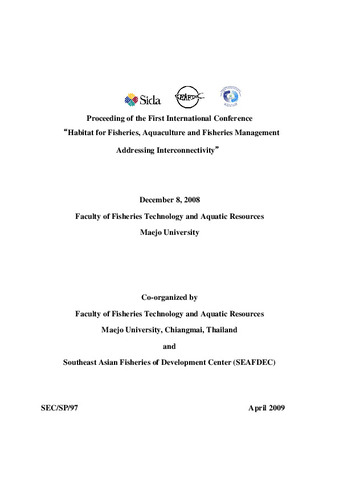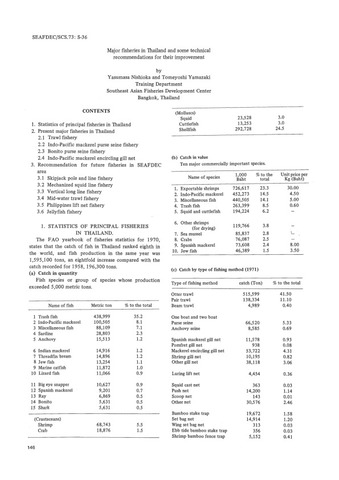Proceeding of the First International Conference “Habitat for Fisheries, Aquaculture and Fisheries Management Addressing Interconnectivity”
Share
นามธรรม
Fish is by many the preferred source of food and considered to be low in cholesterol with high nutritional value. In 2005, the Southeast Asian countries share 14.74% (23,000,000 metric tons) of the world total fisheries production (capture and culture combined). Aquaculture is mostly done as a national operation, which is well within national policy frameworks. In terms of aquaculture, particularly shrimps, Thailand is one of the leading producer countries in world with a global share of around 20%. Indonesia and Vietnam are also among the top five countries producing shrimps from aquaculture. From the point of view of capture fisheries, most of the landings of marine fisheries products are caught within the EEZs of the countries in the region. Taking into account the migratory nature of the fish stocks, the fishing licenses provided to foreign vessels and the mobility of fishing crews, the need to address the management of capture fisheries at regional level becomes very apparent. Illegal, unreported and unregulated (IUU) fishing by foreign vessels has, in addition to “domestic” problems, been receiving increasing attention in the region and there are incidences or conflicts related to fisheries leading to trans-boundary concerns. Therefore, calls for regional and sub-regional fisheries management mechanisms are increasingly being pushed forward. A process is now underway for the establishment of an ASEAN Regional Fisheries Management Mechanism (ARFMM) covering both marine and inland fisheries. While it is expected that the ASEAN broad mechanism would be more general and will not address stocks or species in particular, dialogues are also ongoing at the sub-regional level focusing more on specific habitats and fish species. Apart from the archipelagic waters and “domestic” inland waters, a number of fairly distinct sub-regional fishing areas have been identified, namely: (1) the Lower Mekong River Basin (LMRB) which is a very important freshwater and floodplain fisheries area, shared by Cambodia, Laos PDR, Thailand and Vietnam (CLTV); (2) the Gulf of Thailand sub-regional area which features a large amount of small-scale and coastal fishing operations, large-scale fishing as well as reported IUU fishing and unreported landings across boundaries, shared by Cambodia, Malaysia, Thailand, and Vietnam (CMTV); (3) the Eastern and Southern South China Sea and Sulu Sulawesi Sea sub-regional area characterized also by a large amount of small-scale and coastal fishing, small-scale vessels, large-scale fishing, and IUU fishing, bordered by Brunei Darussalam, Indonesia, Malaysia, Philippines and Vietnam (BIMPV); (4) the Timor-Arafura Sea sub-regional area which features smallscale traditional fishing, industrial fishing for larger pelagic fish including licensed fishing by foreign vessels and IUU fishing, bordered by Australia, Indonesia, Papua New Guinea and Timor Leste (AIPT) (note that Australia, Timor Leste and Papua New Guinea are not members of ASEAN); (5) the Andaman Sea (and Malacca Straits) sub-regional area which shows the same pattern of small-scale, large-scale fisheries and IUU fishing, is shared by India, Indonesia, Malaysia, Myanmar and Thailand (IIMMT) (India is not a member of ASEAN). The management needs were brought forward in reports reflecting the post-tsunami situation; and (6) the Northern South China Sea and the Gulf of Tonkin have similar characteristics as that of the Gulf of Thailand, is shared by China, the Philippines and Vietnam (CPV) (China is not a member of ASEAN). Each sub-region has its specific profile and challenges to address, but the common elements to work on for each sub-regional area management mechanism would include,
as major aspects, information exchange on: fisheries activities (officially recognized fishing and IUU fishing), shared and migratory stocks, results from port monitoring activities (landings by foreign vessels), social mobility of fisheries-related workforce, and laws and institutional arrangements. Other aspects for cooperation at the sub-regions could include networking on Monitoring Control and Surveillance (MCS), mutual support in the implementation of port state and flag state measures, as well as consultations and agreements on the design and zoning of special “management” areas (refugias, protected areas, etc). The fisheries agencies should also push for, while recognizing that this is outside their mandate, the settlement and definitions of maritime boundaries within the area. While recognizing the dominating role of the Southeast Asian countries in the international seafood trade, it can be envisaged that after establishing sub-regional management mechanisms this would help the ASEAN countries to better manage the fisheries and with due recognition by countries around the world help to maintain and increase their exports of fisheries products. In the process, good systems for traceability, certification and labels (such as eco-labels) should also be established. Whatever management measures, the fisheries resources need to be managed and a key element is to limit the fishing capacity while IUU fishing by foreign countries and domestic sources should be prevented.
คอลเลกชัน
รายการที่เกี่ยวข้อง
แสดงรายการที่เกี่ยวข้องตามชื่อผู้แต่งผู้สร้างและเรื่อง
-
The Status of Fisheries in the Republic of Maldives
Faiz, Mohamed (Training Department, Southeast Asian Fisheries Development Center, 1997)The paper discusses the tuna fisheries in Maldives which dominates its fishing industry. Apart from a very strong domestic market, tuna is also the main export commodity of the country. Moreover, reef fisheries such as, ... -
Major fisheries in Thailand and some technical recommendations for their improvement
Nishioka, Yasumasa; Yamazaki, Tomeyoshi (Japan International Cooperation Agency, 1977)Presented in this paper is the development of fisheries industry in Thailand. The data on the production of the principal fisheries species and major fishing methods are also presented. Also included are the recommendations ... -
Status of Fishing Conditions in Cambodia
Sour, Kim; Vuthy, Ros (Training Department, Southeast Asian Fisheries Development Center, 1997)Fisheries in plays a very important role in Cambodia’s national economic development. Total fish catch production in 1996 was 104 310 tones, about which 60% was contributed by inland capture fisheries, 30% by marine capture ...




